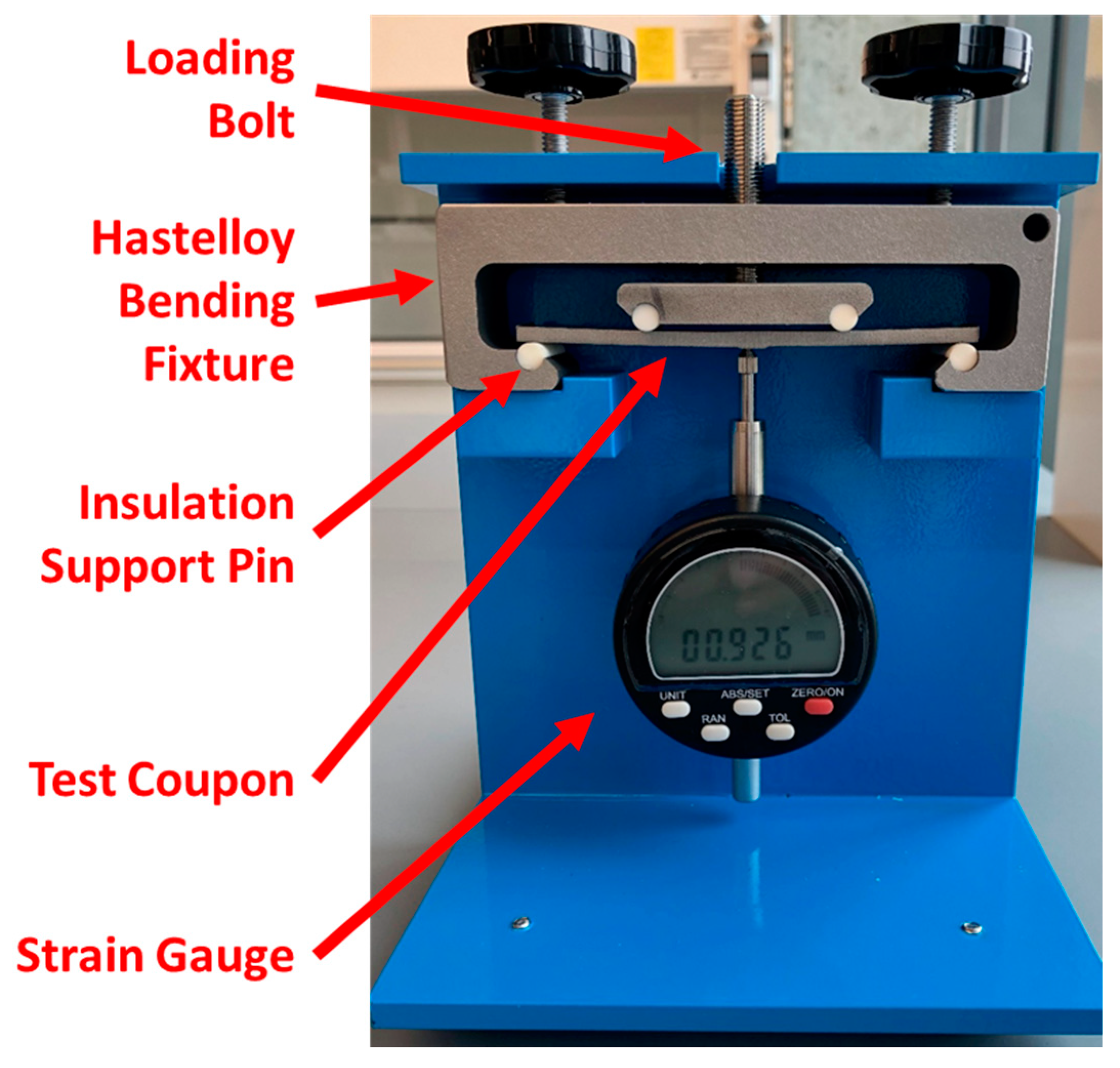Nanoindentation Investigation of Chloride-Induced Stress Corrosion Crack Propagation in an Austenitic Stainless Steel Weld
Abstract
1. Introduction
2. Materials and Methods
3. Results and Discussion
3.1. Grain Structure Revealed by EBSD for Bulk Analysis
3.2. Harndness Distritbution for the Bulk Analysis
3.3. Hardness Mapping and Individual Grain Analysis with NanoBlitz
4. Conclusions
- Grain boundaries and twins do not show a significant impact on hardness compared to randomly oriented grains in the SS 304L HAZ.
- Grain-level mechanical hardness and orientation are not the primary controlling factors that determine the propagation of TGCISCC in the SS 304L HAZ.
- Within an individual cracked grain, hardness is generally highest immediately around the crack due to the elevated dislocation density and strain hardening ahead of crack tips during TGCISCC propagation.
- Nanoindentation techniques corroborate advanced multiscale electron microscopy techniques in identifying CISCC susceptibility and qualitatively assessing CISCC-induced strain hardening.
Supplementary Materials
Author Contributions
Funding
Institutional Review Board Statement
Informed Consent Statement
Data Availability Statement
Acknowledgments
Conflicts of Interest
Abbreviations
| Full Term | Abbreviation |
| Stress corrosion cracking | SCC |
| Intergranular stress corrosion cracking | IGSCC |
| Transgranular stress corrosion cracking | TGSCC |
| Grain boundary | GB |
| Chloride-induced stress corrosion cracking | CISCC |
| Transgranular chloride-induced stress corrosion cracking | TGCISCC |
| Stainless steel | SS |
| Austenitic stainless steel | AuSS |
| Scanning electron microscopy | SEM |
| Electron backscatter diffraction | EBSD |
| Gas tungsten arc weld | GTAW |
| Spent nuclear fuel | SNF |
| Magnesium chloride | MgCl2 |
| Heat-affected zone | HAZ |
| Image quality | IQ |
| Inverse pole figure | IPF |
References
- Fontana, M.G.; Greene, N.D. Corrosion Engineering, McGraw-Hill. 2018. Available online: https://modps71.lib.kmutt.ac.th/xmlui//handle/123456789/310 (accessed on 30 October 2020).
- Jones, D.A. Principles and Prevention of Corrosion; Prentice Hall: Hoboken, NJ, USA, 1996. [Google Scholar]
- Spencer, D.; Edwards, M.; Wenman, M.; Tsitsios, C.; Scatigno, G.; Chard-Tuckey, P. The initiation and propagation of chloride-induced transgranular stress-corrosion cracking (TGSCC) of 304L austenitic stainless steel under atmospheric conditions. Corros. Sci. 2014, 88, 76–88. [Google Scholar] [CrossRef]
- Paccou, E.; Tanguy, B.; Legros, M. Irradiation-assisted stress corrosion cracking susceptibility and mechanical properties related to irradiation-induced microstructures of 304L austenitic stainless steel. J. Nucl. Mater. 2019, 528, 151880. [Google Scholar] [CrossRef]
- Bai, J.; Ritter, S.; Seifert, H.-P.; Virtanen, S. Stress corrosion cracking initiation and short crack growth behaviour in Alloy 182 weld metal under simulated boiling water reactor hydrogen water chemistry conditions. Corros. Sci. 2017, 131, 208–222. [Google Scholar] [CrossRef]
- Panda, B.; Sujata, M.; Madan, M.; Bhaumik, S. Stress corrosion cracking in 316L stainless steel bellows of a pressure safety valve. Eng. Fail. Anal. 2014, 36, 379–389. [Google Scholar] [CrossRef]
- Kumar, M.S.; Sujata, M.; Venkataswamy, M.; Bhaumik, S. Failure analysis of a stainless steel pipeline. Eng. Fail. Anal. 2008, 15, 497–504. [Google Scholar] [CrossRef]
- Winzer, N.; Atrens, A.; Song, G.-L.; Ghali, E.; Dietzel, W.; Kainer, K.U.; Hort, N.; Blawert, C. A Critical Review of the Stress Corrosion Cracking (SCC) of Magnesium Alloys. Adv. Eng. Mater. 2005, 7, 659–693. [Google Scholar] [CrossRef]
- Rao, A.U.; Vasu, V.; Govindaraju, M.; Srinadh, K.S. Stress corrosion cracking behaviour of 7xxx aluminum alloys: A literature review. Trans. Nonferrous Met. Soc. China 2016, 26, 1447–1471. [Google Scholar] [CrossRef]
- Lu, B.; Chen, Z.; Luo, J.; Patchett, B.; Xu, Z. Pitting and stress corrosion cracking behavior in welded austenitic stainless steel. Electrochim. Acta 2005, 50, 1391–1403. [Google Scholar] [CrossRef]
- Stratulat, A.; Duff, J.A.; Marrow, T.J. Grain boundary structure and intergranular stress corrosion crack initiation in high temperature water of a thermally sensitised austenitic stainless steel, observed in situ. Corros. Sci. 2014, 85, 428–435. [Google Scholar] [CrossRef]
- Gertsman, V.; Bruemmer, S. Study of grain boundary character along intergranular stress corrosion crack paths in austenitic alloys. Acta Mater. 2001, 49, 1589–1598. [Google Scholar] [CrossRef]
- Shen, Z.; Arioka, K.; Lozano-Perez, S. A study on the diffusion-induced grain boundary migration ahead of stress corrosion cracking crack tips through advanced characterization. Corros. Sci. 2021, 183, 109328. [Google Scholar] [CrossRef]
- Volpe, L.; Burke, M.; Scenini, F. Correlation between Grain Boundary Migration and Stress Corrosion Cracking of Alloy 600 in Hydrogenated Steam. Acta Mater. 2020, 186, 454–466. [Google Scholar] [CrossRef]
- Sundar, A.; Chen, G.; Qi, L. Substitutional adsorptions of chloride at grain boundary sites on hydroxylated alumina surfaces initialize localized corrosion. NPJ Mater. Degrad. 2021, 5, 18. [Google Scholar] [CrossRef]
- Bruemmer, S.M.; Arey, B.W.; Charlot, L.A. Influence of Chromium Depletion on Intergranular Stress Corrosion Cracking of 304 Stainless Steel. Corrosion 1992, 48, 42–49. [Google Scholar] [CrossRef]
- Smith, T.J.; Staehle, R.W. Role of Slip Step Emergence in the Early Stages of Stress Corrosion Cracking in Face Centered Iron-Nickel-Chromium Alloys. Corrosion 1967, 23, 117–129. [Google Scholar] [CrossRef]
- Andresen, P.L.; Ford, F. Fundamental modeling of environmental cracking for improved design and lifetime evaluation in BWRs. Int. J. Press. Vessel. Pip. 1994, 59, 61–70. [Google Scholar] [CrossRef]
- Magnin, T.; Chambreuil, A.; Bayle, B. The corrosion-enhanced plasticity model for stress corrosion cracking in ductile fcc alloys. Acta Mater. 1996, 44, 1457–1470. [Google Scholar] [CrossRef]
- Zhang, Y.; Cook, A.; Padovani, C.; Zhou, S.; Turnbull, A. Atmospheric stress corrosion crack growth rates of 316 L stainless steel for nuclear waste containment. Corros. Sci. 2020, 177, 109008. [Google Scholar] [CrossRef]
- Tani, J.-I.; Mayuzumi, M.; Hara, N. Stress corrosion cracking of stainless-steel canister for concrete cask storage of spent fuel. J. Nucl. Mater. 2008, 379, 42–47. [Google Scholar] [CrossRef]
- Cook, A.B.; Lyon, S.B.; Stevens, N.P.C.; Gunther, M.; McFiggans, G.; Newman, R.C.; Engelberg, D.L. Assessing the risk of under-deposit chloride-induced stress corrosion cracking in austenitic stainless steel nuclear waste containers. Corros. Eng. Sci. Technol. 2014, 49, 529–534. [Google Scholar] [CrossRef]
- Scatigno, G.; Dong, P.; Ryan, M.; Wenman, M. The effect of salt loading on chloride-induced stress corrosion cracking of 304L austenitic stainless steel under atmospheric conditions. Materialia 2019, 8, 100509. [Google Scholar] [CrossRef]
- Turnbull, A. Corrosion pitting and environmentally assisted small crack growth. Proc. R. Soc. A Math. Phys. Eng. Sci. 2014, 470, 20140254. [Google Scholar] [CrossRef] [PubMed]
- Dong, P.; Scatigno, G.; Wenman, M. Effect of Salt Composition and Microstructure on Stress Corrosion Cracking of 316L Austenitic Stainless Steel for Dry Storage Canisters. J. Nucl. Mater. 2020, 545, 152572. [Google Scholar] [CrossRef]
- Wang, J.-A.J.; Payzant, A.; Bunn, J.R.; An, K. Neutron Residual Stress Mapping for Spent Nuclear Fuel Storage Canister Weldment; Oak Ridge National Lab. (ORNL): Oak Ridge, TN, USA, 2018. [Google Scholar] [CrossRef]
- Qu, H.J.; Tao, F.; Gu, N.; Montoya, T.; Taylor, J.M.; Schaller, R.F.; Schindelholz, E.; Wharry, J.P. Crystallographic effects on transgranular chloride-induced stress corrosion crack propagation of arc welded austenitic stainless steel. NPJ Mater. Degrad. 2022, 6, 43. [Google Scholar] [CrossRef]
- Qu, H. Effect of Crystallography On Stress Corrosion Cracking Growth in Austenitic Stainless Steels; Purdue University: West Lafayette, IN, USA, 2020. [Google Scholar] [CrossRef]
- Zhu, L.; Li, Y. Cleavage-dissolution assisted stress corrosion cracking under elastic loads. NPJ Mater. Degrad. 2021, 5, 25. [Google Scholar] [CrossRef]
- Moss, T.; Was, G. Accelerated Stress Corrosion Crack Initiation of Alloys 600 and 690 in Hydrogenated Supercritical Water. Met. Mater. Trans. A 2017, 48, 1613–1628. [Google Scholar] [CrossRef]
- Shen, Z.; Karamched, P.S.; Arioka, K.; Lozano-Perez, S. Observation and quantification of the diffusion-induced grain boundary migration ahead of SCC crack tips. Corros. Sci. 2018, 147, 163–168. [Google Scholar] [CrossRef]
- Meisnar, M.; Moody, M.; Lozano-Perez, S. Atom probe tomography of stress corrosion crack tips in SUS316 stainless steels. Corros. Sci. 2015, 98, 661–671. [Google Scholar] [CrossRef]
- Schoell, R.; Xi, L.; Zhao, Y.; Wu, X.; Hong, Y.; Yu, Z.; Kenesei, P.; Almer, J.; Shayer, Z.; Kaoumi, D. Mechanism of chlorine-induced stress corrosion cracking of two 304 SS heats in simulated marine environment through in situ X-ray tomography and diffraction: Role of deformation induced martensite and crack branching. Mater. Charact. 2022, 190, 112020. [Google Scholar] [CrossRef]
- Schoell, R.; Xi, L.; Zhao, Y.; Wu, X.; Yu, Z.; Kenesei, P.; Almer, J.; Shayer, Z.; Kaoumi, D. In situ synchrotron X-ray tomography of 304 stainless steels undergoing chlorine-induced stress corrosion cracking. Corros. Sci. 2020, 170, 108687. [Google Scholar] [CrossRef]
- Moore, S.; Burrows, R.; Kumar, D.; Kloucek, M.B.; Warren, A.D.; Flewitt, P.E.J.; Picco, L.; Payton, O.D.; Martin, T.L. Observation of stress corrosion cracking using real-time in situ high-speed atomic force microscopy and correlative techniques. NPJ Mater. Degrad. 2021, 5, 3. [Google Scholar] [CrossRef]
- Mao, K.S.; Sun, C.; Huang, Y.; Shiau, C.-H.; Garner, F.A.; Freyer, P.D.; Wharry, J.P. Grain orientation dependence of nanoindentation and deformation-induced martensitic phase transformation in neutron irradiated AISI 304L stainless steel. Materialia 2019, 5, 100208. [Google Scholar] [CrossRef]
- Dolph, C.K.; da Silva, D.J.; Swenson, M.J.; Wharry, J.P. Plastic zone size for nanoindentation of irradiated Fe–9%Cr ODS. J. Nucl. Mater. 2016, 481, 33–45. [Google Scholar] [CrossRef]
- Mao, K.; Wang, H.; Wu, Y.; Tomar, V.; Wharry, J.P. Microstructure-property relationship for AISI 304/308L stainless steel laser weldment. Mater. Sci. Eng. A 2018, 721, 234–243. [Google Scholar] [CrossRef]
- Mao, K.S.; Sun, C.; Shiau, C.-H.; Yano, K.H.; Freyer, P.D.; El-Azab, A.A.; Garner, F.A.; French, A.; Shao, L.; Wharry, J.P. Role of cavities on deformation-induced martensitic transformation pathways in a laser-welded, neutron irradiated austenitic stainless steel. Scr. Mater. 2019, 178, 1–6. [Google Scholar] [CrossRef]
- Patki, P.V.; Wu, Y.; Wharry, J.P. Effects of proton irradiation on microstructure and mechanical properties of nanocrystalline Cu–10at%Ta alloy. Materialia 2020, 9, 100597. [Google Scholar] [CrossRef]
- Clement, C.; Zhao, Y.; Warren, P.; Liu, X.; Xue, S.; Gandy, D.W.; Wharry, J.P. Comparison of ion irradiation effects in PM-HIP and forged alloy 625. J. Nucl. Mater. 2021, 558, 153390. [Google Scholar] [CrossRef]
- Saleh, M.; Zaidi, Z.; Hurt, C.; Ionescu, M.; Munroe, P.; Bhattacharyya, D. Comparative Study of Two Nanoindentation Approaches for Assessing Mechanical Properties of Ion-Irradiated Stainless Steel 316. Metals 2018, 8, 719. [Google Scholar] [CrossRef]
- Bhattacharyya, D.; Hurt, C.; Xu, A.; Ionescu, M. An Analytical Model for Oblique Cross Section Nanoindentation of Ion-Irradiated Metallic Alloys Based on Studies of Oxide Dispersion Strengthened Steel MA957. Adv. Eng. Mater. 2021, 23, 2001431. [Google Scholar] [CrossRef]
- Gasparrini, C.; Xu, A.; Short, K.; Wei, T.; Davis, J.; Palmer, T.; Bhattacharyya, D.; Edwards, L.; Wenman, M. Micromechanical testing of unirradiated and helium ion irradiated SA508 reactor pressure vessel steels: Nanoindentation vs in-situ microtensile testing. Mater. Sci. Eng. A 2020, 796, 139942. [Google Scholar] [CrossRef]
- Hosemann, P.; Vieh, C.; Greco, R.; Kabra, S.; Valdez, J.; Cappiello, M.; Maloy, S. Nanoindentation on ion irradiated steels. J. Nucl. Mater. 2009, 389, 239–247. [Google Scholar] [CrossRef]
- Krumwiede, D.; Yamamoto, T.; Saleh, T.; Maloy, S.; Odette, G.; Hosemann, P. Direct comparison of nanoindentation and tensile test results on reactor-irradiated materials. J. Nucl. Mater. 2018, 504, 135–143. [Google Scholar] [CrossRef]
- Kareer, A.; Prasitthipayong, A.; Krumwiede, D.; Collins, D.; Hosemann, P.; Roberts, S. An analytical method to extract irradiation hardening from nanoindentation hardness-depth curves. J. Nucl. Mater. 2018, 498, 274–281. [Google Scholar] [CrossRef]
- Enos, D.; Bryan, C.R. Final Report: Characterization of Canister Mockup Weld Residual Stresses; OSTI: Oak Ridge, TN, USA, 2016. [Google Scholar] [CrossRef][Green Version]
- Qu, H.J.; Srinivasan, J.; Zhao, Y.; Mao, K.S.; Taylor, J.M.; Marino, G.; Montoya, T.; Johnson, K.; Locke, J.S.; Schaller, R.; et al. Stress corrosion cracking mechanism of cold spray coating on a galvanically similar substrate. Mater. Sci. Eng. A 2022, 849, 143404. [Google Scholar] [CrossRef]
- Qu, H.J.; Wharry, J.P. Crystallographic orientation data from chloride-induced stress corrosion crack (CISCC) paths in gas tungsten arc welded (GTAW) austenitic stainless steel 304L. Data Brief 2022, 42, 108059. [Google Scholar] [CrossRef]
- ASTM-G36-94; Standard Practice for Evaluating Stress-Corrosion-Cracking Resistance of Metals and Alloys in a Boiling Magnesium Chloride Solution. ASTM International: West Conshohocken, PA, USA, 2013.
- Oliver, W.C.; Pharr, G.M. An improved technique for determining hardness and elastic modulus using load and displacement sensing indentation experiments. J. Mater. Res. 1992, 7, 1564–1583. [Google Scholar] [CrossRef]
- Phani, P.S.; Oliver, W. A critical assessment of the effect of indentation spacing on the measurement of hardness and modulus using instrumented indentation testing. Mater. Des. 2018, 164, 107563. [Google Scholar] [CrossRef]
- Ke, R.; Hu, C.; Zhong, M.; Wan, X.; Wu, K. Grain refinement strengthening mechanism of an austenitic stainless steel: Critically analyze the impacts of grain interior and grain boundary. J. Mater. Res. Technol. 2022, 17, 2999–3012. [Google Scholar] [CrossRef]
- Voyiadjis, G.Z.; Zhang, C. The mechanical behavior during nanoindentation near the grain boundary in a bicrystal FCC metal. Mater. Sci. Eng. A 2015, 621, 218–228. [Google Scholar] [CrossRef]
- Tsuru, T.; Kaji, Y.; Matsunaka, D.; Shibutani, Y. Incipient plasticity of twin and stable/unstable grain boundaries during nanoindentation in copper. Phys. Rev. B 2010, 82, 024101. [Google Scholar] [CrossRef]
- Tsuru, T.; Shibutani, Y.; Kaji, Y. Fundamental interaction process between pure edge dislocation and energetically stable grain boundary. Phys. Rev. B 2009, 79, 012104. [Google Scholar] [CrossRef]
- Lu, Z.; Shoji, T.; Meng, F.; Xue, H.; Qiu, Y.; Takeda, Y.; Negishi, K. Characterization of microstructure and local deformation in 316NG weld heat-affected zone and stress corrosion cracking in high temperature water. Corros. Sci. 2011, 53, 1916–1932. [Google Scholar] [CrossRef]
- Shen, Z.; Chen, K.; Tweddle, D.; He, G.; Arioka, K.; Lozano-Perez, S. Characterization of the crack initiation and propagation in Alloy 600 with a cold-worked surface. Corros. Sci. 2019, 152, 82–92. [Google Scholar] [CrossRef]
- Karlsen, W.; Diego, G.; Devrient, B. Localized deformation as a key precursor to initiation of intergranular stress corrosion cracking of austenitic stainless steels employed in nuclear power plants. J. Nucl. Mater. 2010, 406, 138–151. [Google Scholar] [CrossRef]
- Byun, T.; Hashimoto, N.; Farrell, K. Temperature dependence of strain hardening and plastic instability behaviors in austenitic stainless steels. Acta Mater. 2004, 52, 3889–3899. [Google Scholar] [CrossRef]
- Haouala, S.; Alizadeh, R.; Bieler, T.; Segurado, J.; Llorca, J. Effect of slip transmission at grain boundaries in Al bicrystals. Int. J. Plast. 2019, 126, 102600. [Google Scholar] [CrossRef]
- Sangid, M.D.; Ezaz, T.; Sehitoglu, H.; Robertson, I.M. Energy of slip transmission and nucleation at grain boundaries. Acta Mater. 2011, 59, 283–296. [Google Scholar] [CrossRef]
- Meisnar, M.; Vilalta-Clemente, A.; Moody, M.; Arioka, K.; Lozano-Perez, S. A mechanistic study of the temperature dependence of the stress corrosion crack growth rate in SUS316 stainless steels exposed to PWR primary water. Acta Mater. 2016, 114, 15–24. [Google Scholar] [CrossRef]
- Sennour, M.; Laghoutaris, P.; Guerre, C.; Molins, R. Advanced TEM characterization of stress corrosion cracking of Alloy 600 in pressurized water reactor primary water environment. J. Nucl. Mater. 2009, 393, 254–266. [Google Scholar] [CrossRef]
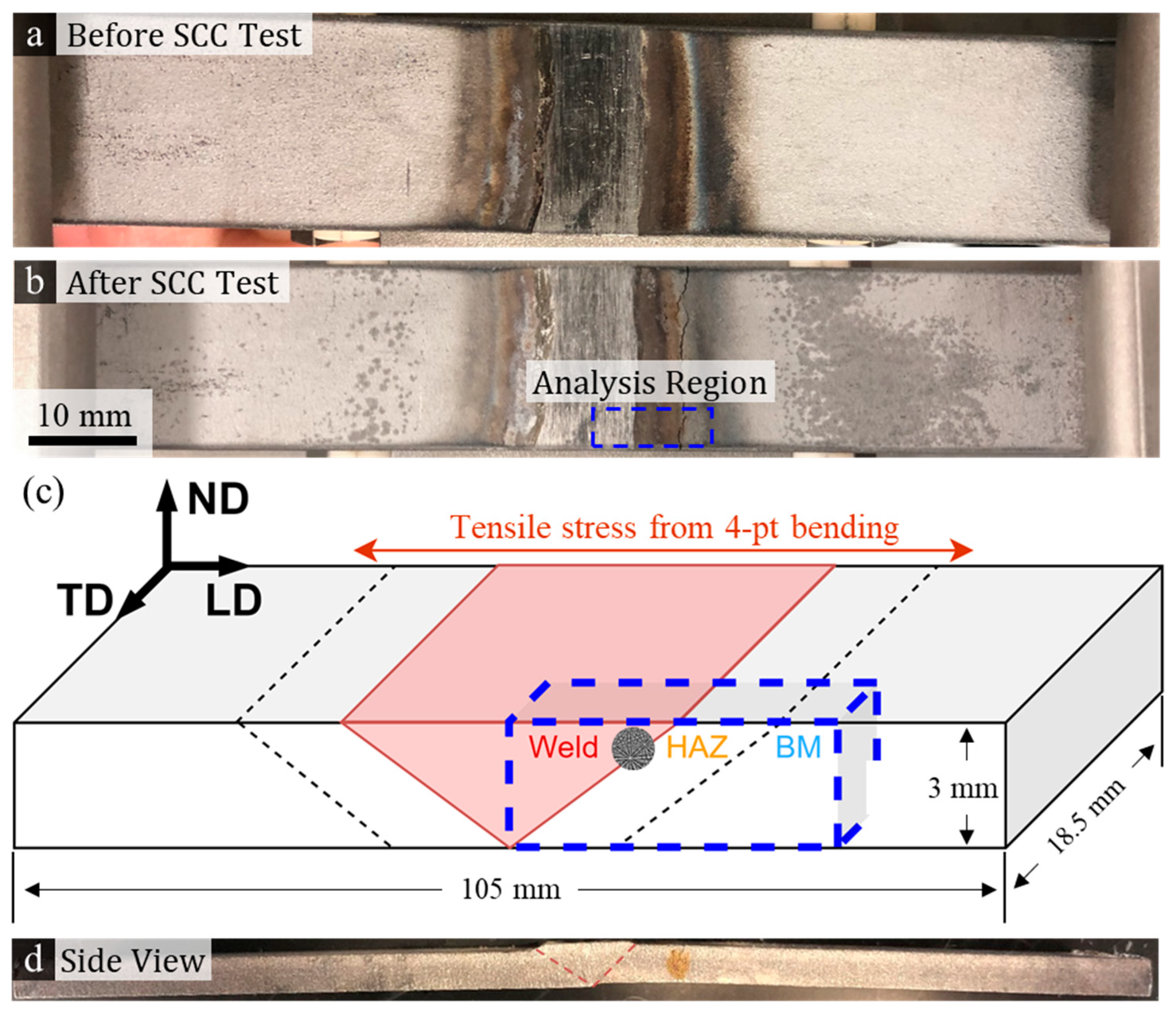
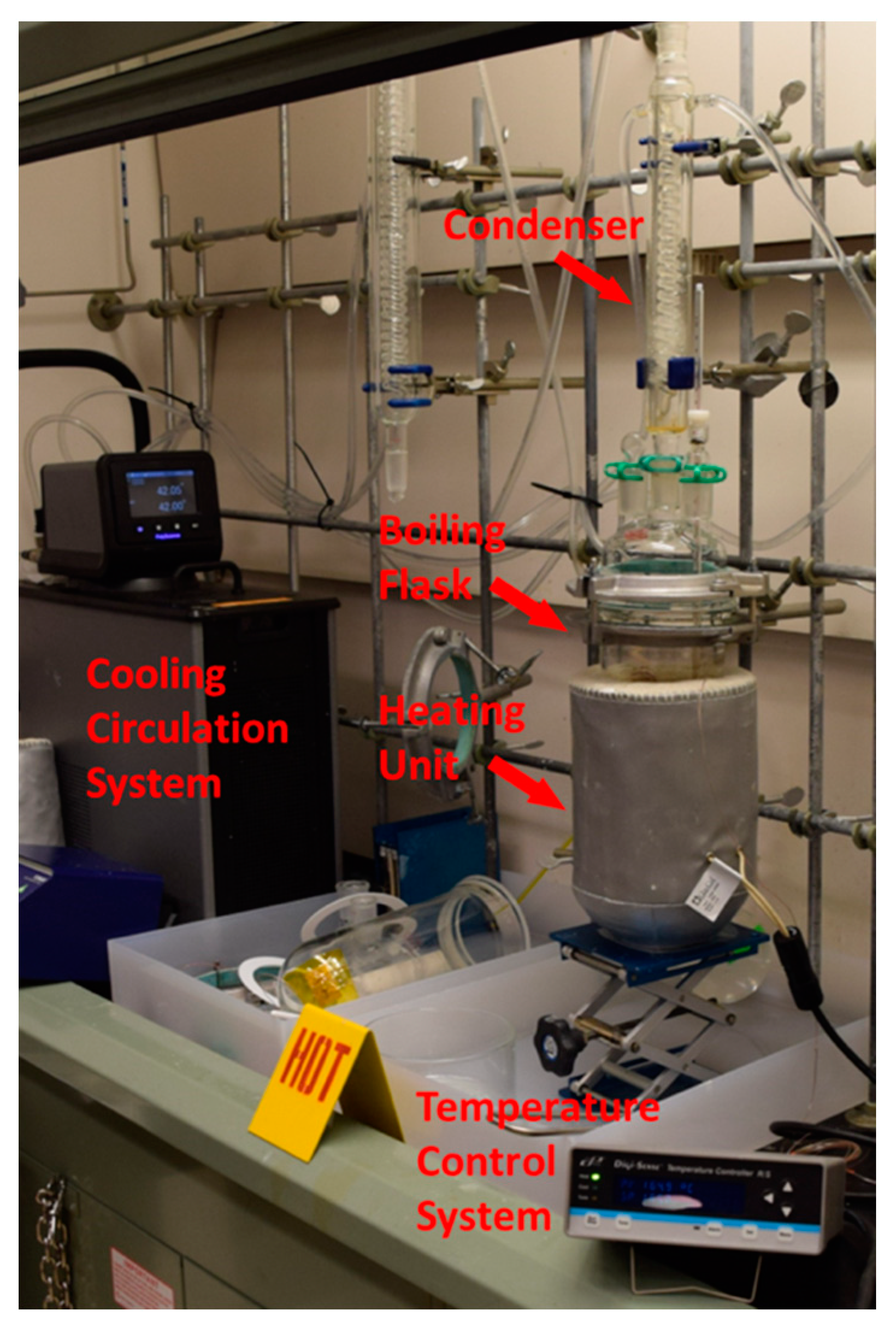


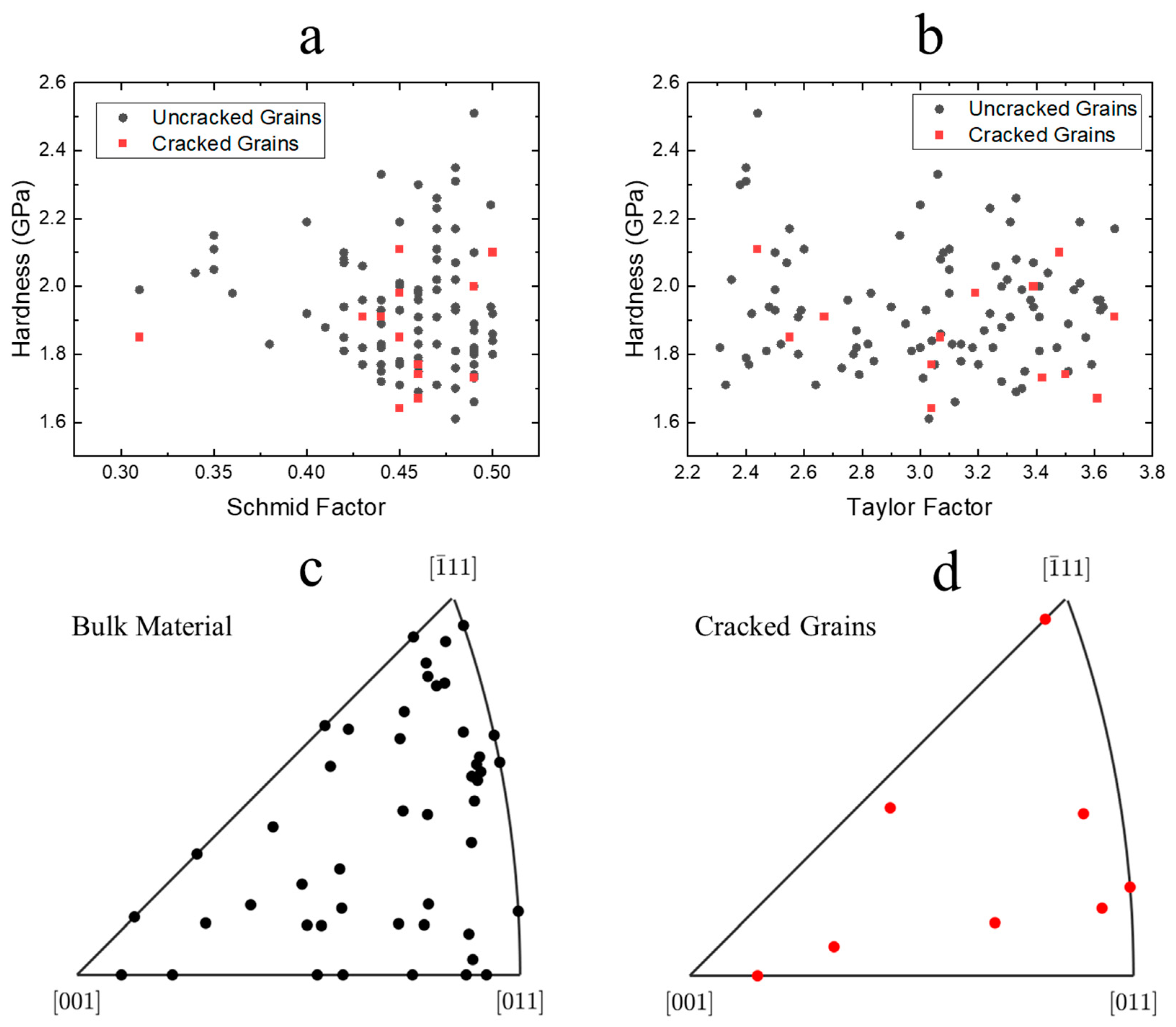
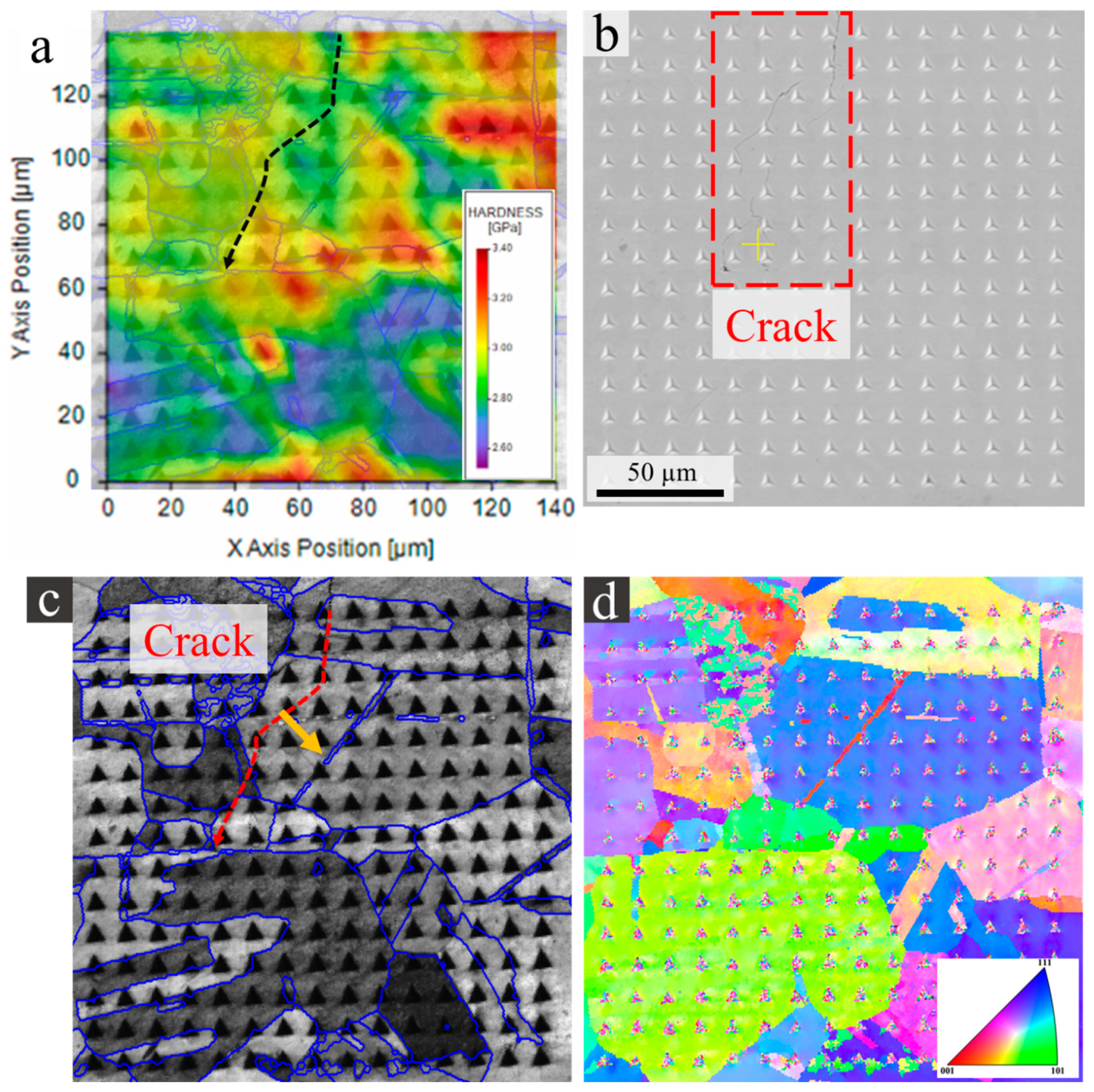

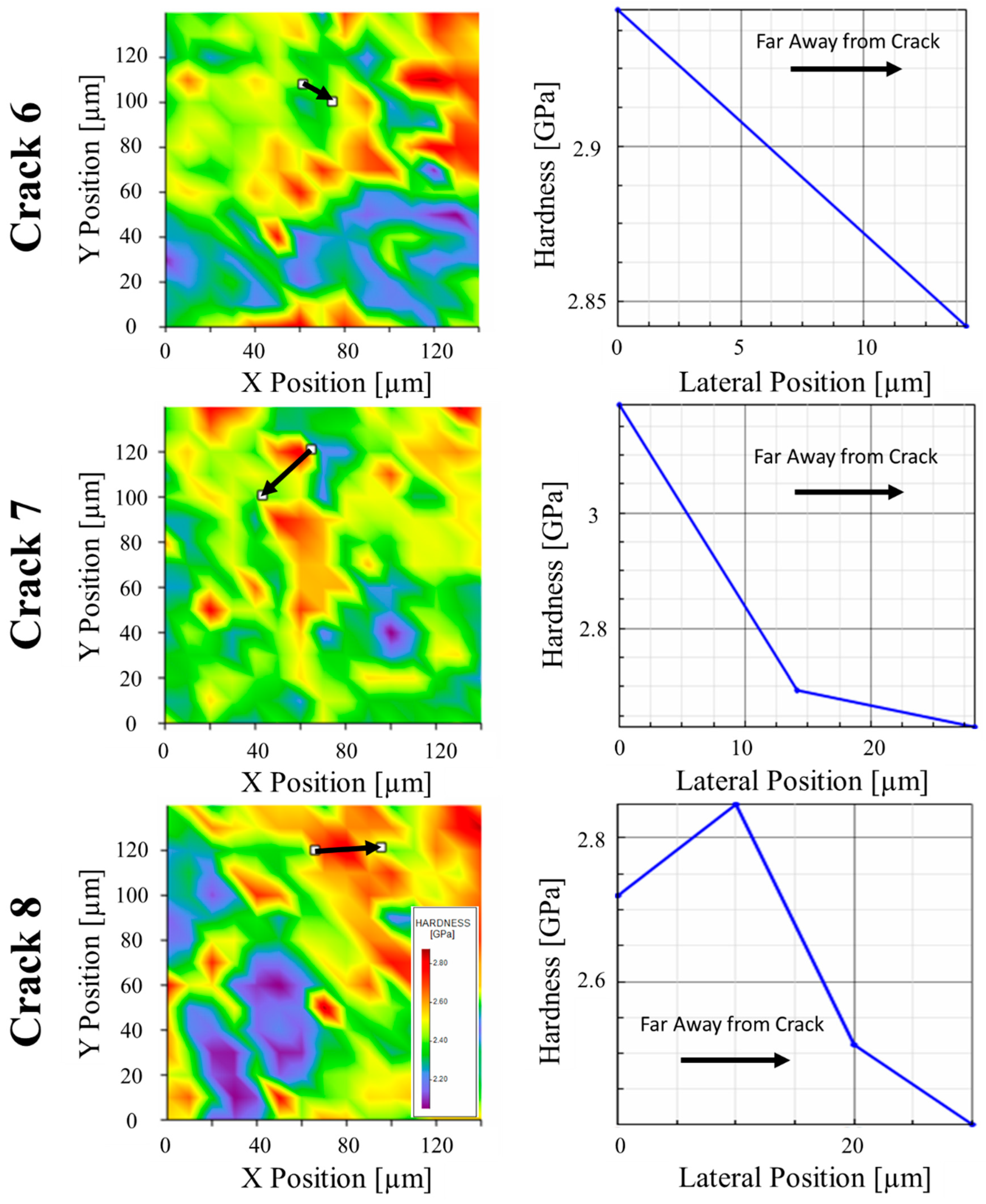
| Materials | Alloying wt.% (Balance Fe) | |||||||||
|---|---|---|---|---|---|---|---|---|---|---|
| C | Si | Cr | P | S | N | Mn | Ni | Cu | Mo | |
| SS 30403 | 0.027 | 0.35 | 18.11 | 0.023 | 0.04 | 0.056 | 1.31 | 8.02 | - | - |
| SS 30880 | 0.014 | 0.47 | 19.88 | 0.021 | 0.002 | - | 1.83 | 9.66 | 0.1 | 0.01 |
Publisher’s Note: MDPI stays neutral with regard to jurisdictional claims in published maps and institutional affiliations. |
© 2022 by the authors. Licensee MDPI, Basel, Switzerland. This article is an open access article distributed under the terms and conditions of the Creative Commons Attribution (CC BY) license (https://creativecommons.org/licenses/by/4.0/).
Share and Cite
Qu, H.J.; Wharry, J.P. Nanoindentation Investigation of Chloride-Induced Stress Corrosion Crack Propagation in an Austenitic Stainless Steel Weld. Metals 2022, 12, 1243. https://doi.org/10.3390/met12081243
Qu HJ, Wharry JP. Nanoindentation Investigation of Chloride-Induced Stress Corrosion Crack Propagation in an Austenitic Stainless Steel Weld. Metals. 2022; 12(8):1243. https://doi.org/10.3390/met12081243
Chicago/Turabian StyleQu, Haozheng J., and Janelle P. Wharry. 2022. "Nanoindentation Investigation of Chloride-Induced Stress Corrosion Crack Propagation in an Austenitic Stainless Steel Weld" Metals 12, no. 8: 1243. https://doi.org/10.3390/met12081243
APA StyleQu, H. J., & Wharry, J. P. (2022). Nanoindentation Investigation of Chloride-Induced Stress Corrosion Crack Propagation in an Austenitic Stainless Steel Weld. Metals, 12(8), 1243. https://doi.org/10.3390/met12081243





